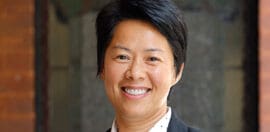Communicating social progress – How to use ‘theory of change’ effectively

23 April 2019 at 8:53 am
Theories of change have the potential to bridge the divide between numbers and visual thinkers, writes Mike Davis, in this article which shares his learnings from running a recent theory of change workshop.
When you communicate with most audiences, you are transmitting ideas to a collection of individuals; all of whom think differently. Some people prefer stories and derive more meaning from them, others prefer hard data and forecasts.
This became apparent to me recently during a presentation at Leadership Victoria on the Scanlon Foundation’s Mapping Social Cohesion 2018 survey. The presentation showed a number of slides on the findings, and key data points from the results of this survey.
I was amongst a small minority of people who asked questions about the survey construction, design, potential biases, methodology and sampling method. For me, how we design and implement surveys is essential and inseparable from how we interpret results and place them in a balanced context.
This was not the view of the majority of the room, who grew weary of my probing questions! When it comes to understanding social change, I’m a firm believer in compelling narratives supported by robust and transparent data.
Data and stories
What I was beginning to see in that room, and what I have seen over the years working in the for-purpose sector, is that it is always a combination of robust numbers and frameworks complementing good stories and narratives that influence hearts and minds.
You have to assume that half the room wants data and structure, and the other half wants good stories. This is why I think the theory of change is such an important tool.
It has the potential to bridge the divide between numbers and visual thinkers. Lovers of non-fiction and fiction, data and narrative.
Theories of change
A theory of change is a great way to explain how your program or organisation is able to take certain inputs or resources and convert them into positive social outcomes and impact over time.
The reason a theory of change can be such a valuable tool is that it shows the connection between volume of activity and degree of change within a system. This connects with the move in funder preferences from a volumetric or quantity equals success, to a percentage improvement or quality equals success lens.
At a recent Gather event, I was on a panel on social impact measurement and tried to explain the theory of change as “understanding how the sausage machine works”.
For the purposes of this example, imagine the new “healthy sausage machine” operates at a foodbank that is serving hungry communities in need.

I’ve outlined the key questions to ask above in dark blue required to populate these boxes. In particular, think of inputs and outputs as quite tangible or physical and you should be able to count them as numbers of dollars. Outputs are similar and should be in unit form.
The output is a tangible good or a program or service and equally can be counted. Outcomes measure the change that you’ve realised in both the short and longer term from producing those outputs.
Impact is really asking, what is the long-lasting change that you’ve made in the community as a result of your program or outputs? For outcomes and impact you’ll more likely be looking for percentages or degrees of change rather than units.
Youth Hub workshop
Earlier in the month at TaskForce Community Agency, we ran a theory of change workshop with our clinicians and management to make sure what we were designing was a good fit for how the Youth Hub was running and was intended to run.
At this workshop I had already done a draft theory of change which I took to the workshop to further refine with colleagues. This was a good option at TaskForce given how busy our staff are with heavy client loads.

However, you may wish to run a theory of change workshop from scratch to frame your theory of change from the start.
You could do this by following the basic table above and leaving connecting up the elements until the workshop.
Here are the key stages of the workshop that I think worked well that I would suggest emulating in any of your own workshops:
1. What makes a good story? (Ice-Breaker)
- Generally
- From the perspective of a funder
- Compare and contrast
2. What is a theory of change? (Intro)
- Why
- What
- Who
- How
3. Outputs and Outcomes (Complexity)
- What is the difference?
- Why does it matter?
- How do we measure it?
- Who does it matter to?
4. What is Impact (Exploration)
- Why does it matter?
- How do we measure it?
- Who does it matter to?
5. Connecting the elements (Applied)
- What is the causal chain between the elements? (outputs, outcomes, impact)
- Which chains are the most important for impact?
- How are they interacting with each other?
For step five and for any theory of change workshop, I recommend SVA’s golden thread methodology and this article as great pre-reading.
An improvement we will make for next time will be to include some of our clients in the workshop.
Although we capture feedback and data from our clients through our system, there is nothing like having client voices in the room to inform the process.
This is our current theory of change, but as our Youth Hub evolves and grows it will need to be regularly updated!

Key messages
- A theory of change is a powerful tool in explaining how your program creates impact.
- It combines the data and visual process flow well to make sense to a range of audiences.
- These are best created or refined using workshops consisting of staff and clients/users.
- They should be updated regularly to ensure they still reflect how a program works in practice.








It is worthwhile to be reminded that it is a theory of*probable* change only. With the world increasingly complex where every part/agent is connected to another, it would be a miracle if the change eventuated as theorised. I believe it is more useful to build capacities in these 5 capacities to tackle uncertainty (VUCA) effectively – http://www.fauc.eu